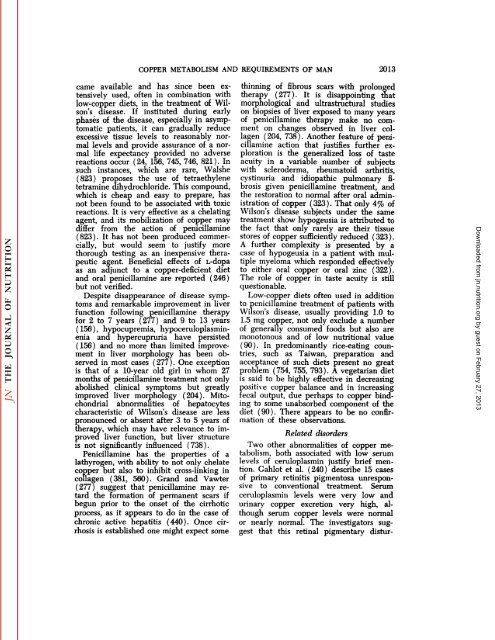conspectus of researchon copper metabolism and requirements
conspectus of researchon copper metabolism and requirements
conspectus of researchon copper metabolism and requirements
Create successful ePaper yourself
Turn your PDF publications into a flip-book with our unique Google optimized e-Paper software.
COPPER METABOLISM AND REQUIREMENTS OF MAN 2013<br />
came available <strong>and</strong> has since been ex<br />
tensively used, <strong>of</strong>ten in combination with<br />
low-<strong>copper</strong> diets, in the treatment <strong>of</strong> Wil<br />
son's disease. If instituted during early<br />
phases <strong>of</strong> the disease, especially in asymp<br />
tomatic patients, it can gradually reduce<br />
excessive tissue levels to reasonably nor<br />
mal levels <strong>and</strong> provide assurance <strong>of</strong> a nor<br />
mal life expectancy provided no adverse<br />
reactions occur (24, 156, 745, 746, 821). In<br />
such instances, which are rare, Walshe<br />
(823) proposes the use <strong>of</strong> tetraethylene<br />
tetramine dihydrochloride. This compound,<br />
which is cheap <strong>and</strong> easy to prepare, has<br />
not been found to be associated with toxic<br />
reactions. It is very effective as a chelating<br />
agent, <strong>and</strong> its mobilization <strong>of</strong> <strong>copper</strong> may<br />
differ from the action <strong>of</strong> penicillamine<br />
(823). It has not been produced commer<br />
cially, but would seem to justify more<br />
thorough testing as an inexpensive thera<br />
peutic agent. Beneficial effects <strong>of</strong> L-dopa<br />
as an adjunct to a <strong>copper</strong>-deficient diet<br />
<strong>and</strong> oral penicillamine are reported (246)<br />
but not verified.<br />
Despite disappearance <strong>of</strong> disease symp<br />
toms <strong>and</strong> remarkable improvement in liver<br />
function following penicillamine therapy<br />
for 2 to 7 years (277) <strong>and</strong> 9 to 13 years<br />
(156), hypocupremia, hypoceruloplasminenia<br />
<strong>and</strong> hypercupruria have persisted<br />
( 156) <strong>and</strong> no more than limited improve<br />
ment in liver morphology has been ob<br />
served in most cases (277). One exception<br />
is that <strong>of</strong> a 10-year old girl in whom 27<br />
months <strong>of</strong> penicillamine treatment not only<br />
abolished clinical symptoms but greatly<br />
improved liver morphology (204). Mitochondrial<br />
abnormalities <strong>of</strong> hepatocytes<br />
characteristic <strong>of</strong> Wilson's disease are less<br />
pronounced or absent after 3 to 5 years <strong>of</strong><br />
therapy, which may have relevance to im<br />
proved liver function, but liver structure<br />
is not significantly influenced (738).<br />
Penicillamine has the properties <strong>of</strong> a<br />
lathyrogen, with ability to not only chelate<br />
<strong>copper</strong> but also to inhibit cross-linking in<br />
collagen (381, 560). Gr<strong>and</strong> <strong>and</strong> Vawter<br />
(277) suggest that penicillamine may re<br />
tard the formation <strong>of</strong> permanent scars if<br />
begun prior to the onset <strong>of</strong> the cirrhotic<br />
process, as it appears to do in the case <strong>of</strong><br />
chronic active hepatitis (440). Once cir<br />
rhosis is established one might expect some<br />
thinning <strong>of</strong> fibrous scars with prolonged<br />
therapy (277). It is disappointing that<br />
morphological <strong>and</strong> ultrastructural studies<br />
on biopsies <strong>of</strong> liver exposed to many years<br />
<strong>of</strong> penicillamine therapy make no com<br />
ment on changes observed in liver col<br />
lagen (204, 738 ). Another feature <strong>of</strong> peni<br />
cillamine action that justifies further ex<br />
ploration is the generalized loss <strong>of</strong> taste<br />
acuity in a variable number <strong>of</strong> subjects<br />
with scleroderma, rheumatoid arthritis,<br />
cystinuria <strong>and</strong> idiopathic pulmonary fibrosis<br />
given penicillamine treatment, <strong>and</strong><br />
the restoration to normal after oral admin<br />
istration <strong>of</strong> <strong>copper</strong> (323). That only 4% <strong>of</strong><br />
Wilson's disease subjects under the same<br />
treatment show hypogeusia is attributed to<br />
the fact that only rarely are their tissue<br />
stores <strong>of</strong> <strong>copper</strong> sufficiently reduced (323 ).<br />
A further complexity is presented by a<br />
case <strong>of</strong> hypogeusia in a patient with mul<br />
tiple myeloma which responded effectively<br />
to either oral <strong>copper</strong> or oral zinc (322).<br />
The role <strong>of</strong> <strong>copper</strong> in taste acuity is still<br />
questionable.<br />
Low-<strong>copper</strong> diets <strong>of</strong>ten used in addition<br />
to penicillamine treatment <strong>of</strong> patients with<br />
Wilson's disease, usually providing 1.0 to<br />
1.5 mg <strong>copper</strong>, not only exclude a number<br />
<strong>of</strong> generally consumed foods but also are<br />
monotonous <strong>and</strong> <strong>of</strong> low nutritional value<br />
(90). In predominantly rice-eating coun<br />
tries, such as Taiwan, preparation <strong>and</strong><br />
acceptance <strong>of</strong> such diets present no great<br />
problem (754, 755, 793). A vegetarian diet<br />
is said to be highly effective in decreasing<br />
positive <strong>copper</strong> balance <strong>and</strong> in increasing<br />
fecal output, due perhaps to <strong>copper</strong> bind<br />
ing to some unabsorbed component <strong>of</strong> the<br />
diet (90). There appears to be no confir<br />
mation <strong>of</strong> these observations.<br />
Related disorders<br />
Two other abnormalities <strong>of</strong> <strong>copper</strong> me<br />
tabolism, both associated with low serum<br />
levels <strong>of</strong> ceruloplasmin justify brief men<br />
tion. Gahlot et al. (240) describe 15 cases<br />
<strong>of</strong> primary retinitis pigmentosa unrespon<br />
sive to conventional treatment. Serum<br />
ceruloplasmin levels were very low <strong>and</strong><br />
urinary <strong>copper</strong> excretion very high, al<br />
though serum <strong>copper</strong> levels were normal<br />
or nearly normal. The investigators sug<br />
gest that this retinal pigmentary distur-<br />
Downloaded from<br />
jn.nutrition.org<br />
by guest on February 27, 2013
















